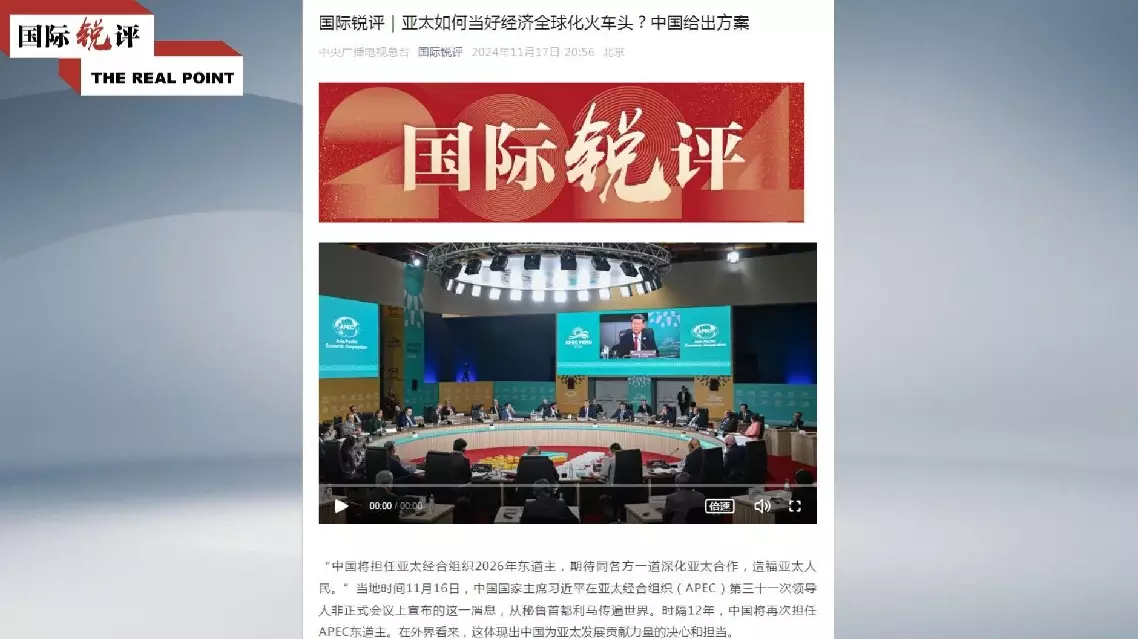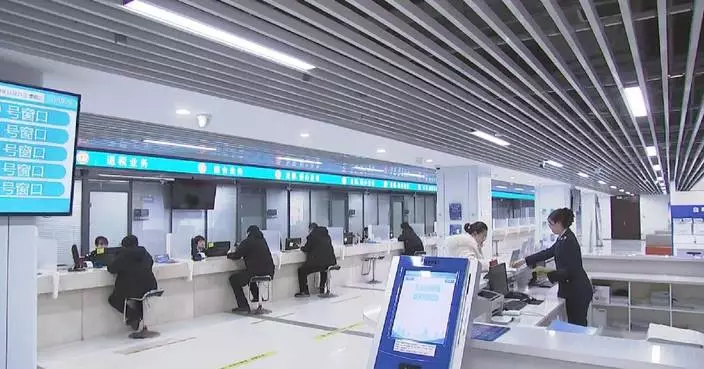Chinese President Xi Jinping's speeches at the 31st APEC Economic Leaders' Meeting in Lima, Peru offered solutions to questions of the times on how the Asia-Pacific region should remain the driving force of economic globalization and forge the next “30 golden years” of development, said a commentary released by the China Media Group (CMG) on Sunday.
An edited English-language version of the commentary is as follows:
"China will host APEC 2026. We look forward to working with all parties to deepen Asia-Pacific cooperation to the benefit of the peoples in the region," Chinese President Xi Jinping announced at the 31st APEC Economic Leaders' Meeting in Lima, Peru on Saturday.
It will be the first time for China to host APEC in 12 years, and Xi’s speech shows the rest of the world China's determination and responsibility to contribute to the development of the Asia-Pacific region.
Since 2013, President Xi has expounded on the proposition of building an Asia-Pacific community with a shared future on many international occasions. This time, at the historic crossroads, President Xi presented a Chinese solution once again. It has been noticed that in both titles of President Xi’s speeches at the APEC Economic Leaders' Meeting and the APEC CEO Summit, there was a key world "times." So, what kind of times are we living in? How do we answer to questions of our times?
Currently, the world is in a period of turbulence and transformation, with sluggish global economic growth, rising unilateralism and protectionism, and headwinds against economic globalization.
According to the World Openness Report 2024, the world openness index in 2023 was 5.43 percent lower than in 2008.
In the meantime, a new round of scientific and technological revolution and industrial transformation is well under way, building up strong momentum for further acceleration of economic globalization.
At this critical historic moment, President Xi pointed out clearly that economic globalization has always been the general trend despite headwinds and setbacks. Economic globalization is now caught in a tug of war between driving and obstructive forces, but the driving forces still prevail. Economic globalization should be steered in the right direction to ensure that it generates more positive outcomes and is taken to a new phase that is more dynamic, inclusive and sustainable...These important remarks, following his speech at the World Economic Forum seven years ago, have once again charted the course for economic globalization and greatly boosted the confidence of the Asia-Pacific in continuing to play a good role as the driving force of economic globalization.
As a region with the world's most dynamic economic growth, the Asia-Pacific has created a world-renowned "miracle" over the past few decades thanks to its peaceful and stable environment and its commitment to multilateralism and open regionalism.
In face of drastic changes unseen in a century and in a world of both opportunities and challenges, how to forge the next "30 golden years" of Asia-Pacific development? The answer still lies in the general trend of economic globalization.
We need to build an open and interconnected paradigm for Asia-Pacific cooperation, make green innovation a catalyst for the Asia-Pacific, and uphold a universally beneficial and inclusive vision for Asia-Pacific development, President Xi proposed at the APEC summit, charting the course for building a Asia-Pacific community with a shared future and starting a new era in Asia-Pacific development.
The three proposals are summarized from China's successful experiences in modernization and interaction with the Asia-Pacific region, which embody China's new development philosophy, conform to the trend of economic globalization, and have strong practical relevance and far-reaching significance, said Liu Chenyang, director of APEC Study Center at Nankai University.
Openness and inclusiveness are the hallmarks of the Asia-Pacific. Ten years ago, a historic decision to kick off the process of a Free Trade Area of the Asia-Pacific was taken at the APEC Economic Leaders' Meeting in Beijing. At this year's summit, a new document was adopted to guide this process, which is regarded as an important outcome.
Analysts believe the new document represents the efforts and determination of the Asia-Pacific to promote trade liberalization in the region and is crucial for realizing Putrajaya Vision 2040.
True development means common development of all countries. For the Asia-Pacific region, it is integral to jointly make bigger the pie of the economic development and share it equally to let more economies and more people to enjoy the fruits of development when promoting universally beneficial and inclusive economic globalization.
China has always been committed to a people-centered development approach. At the summit, China said it will advance initiatives through the APEC platform on increasing residents' income and promoting the industrial cluster development of small and medium-sized enterprises. This will enhance people's well-being in the Asia-Pacific, promote social fairness and justice, and bring about universally beneficial and inclusive development of Asia-Pacific economies.
Green and digital areas are the new hallmarks of the Asia-Pacific. At this summit, President Xi proposed to take innovation as the source of productive forces, make full use of artificial intelligence and other emerging technologies to rev up the world economy, and stimulate its growth with the current technological revolution.
What's worth noting is that China announced it will launch a Global Cross-Border Data Flow Cooperation Initiative.
This initiative is of great significance as it provides fundamental support for China to speed up cooperation with other countries in digital economy and demonstrates the country's activeness and open mind in the development of digital economy, said Wei Liang, deputy director of Institute of Macroeconomics and Strategy, China Institutes of Contemporary International Relations.
As an important member of the Asia-Pacific community, China's development is inseparable from the Asia-Pacific, and it will in turn further benefit the region.
The Third Plenary Session of the 20th Central Committee of the Communist Party of China (CPC) held earlier this year laid out systematic plans for further deepening reform comprehensively to advance Chinese modernization.
At the APEC summit, President Xi stated clearly that China will deepen reform comprehensively, promote high-quality development, remain committed to the path of green development, and build new systems for higher-level open economy, which, in turn, will benefit the Asia-Pacific and inject new impetus into global economic growth with China's new development.
The Chancay Airport has grabbed the spotlight within the APEC community. "A port of all, a port for all" is a slogan on quay cranes at the new port in Peru. It reflects the goal of the Asia-Pacific's efforts in opening up, cooperation and promoting economic globalization, which is to benefit everyone.
It can be expected that APEC members will further burnishing the Asia-Pacific hallmark of openness and inclusiveness, make new brand-building efforts to foster a green and digital Asia-Pacific, turn the vast Pacific into a thoroughfare for more prosperity and growth, and usher in another 30 golden years of development for the region.

China offers solution for Asia-Pacific to remain driving force for economic globalization: commentary









